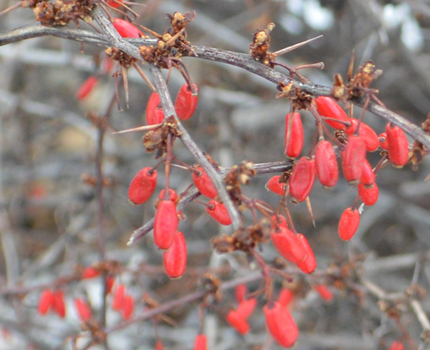by Matt Corrion
Succulents and cacti are amazing plants that are under-utilized in Colorado landscapes. These photos are from a trip I took last week to Southern California. While many of these plants would not be hardy in colder climates they are nonetheless just as beautiful and interesting. Thankfully, there are many cacti and succulents such as many varieties of Opuntia, Cholla, Agave, and Sedum that are cold hearty and will thrive in a dry landscape with minimal watering or maintenance.
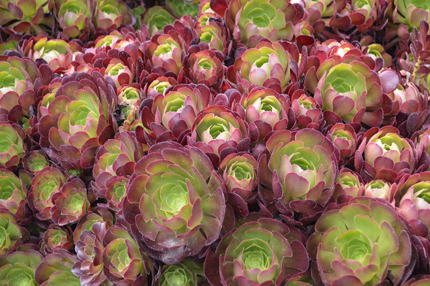

This is the official blog of Outdoor Design Group, Colorado Landscape Architects. For more information about our business and our services, click here.
Related Posts:
by Matt Corrion
Have you noticed how amazing the Brooms around Denver are looking right now? This one I photographed in Aurora is just beginning to explode into bloom. Sadly, many of the flowering trees and Lilacs along the front range got zapped by the late cold spells we had, and few will produce showy flowers this year. It is nice to have amazing drought tolerant plants like Cytisus purgans ‘Spanish Gold’ to pick up the slack.
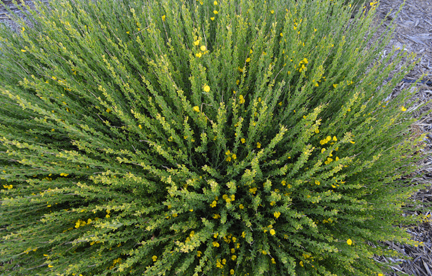
This is the official blog of Outdoor Design Group, Colorado Landscape Architects. For more information about our business and our services, click here.
Related Posts:
by Matt Corrion
Despite the recent rain across Colorado, much of the state remains in a drought.
The watering restrictions that Denver Water put in place for this year remain in place, having gone into effect on April 1st.
You may be aware that watering restrictions mean you can only water two days per week, but how long should you run your lawn sprinklers on those days? Denver Water recently released this chart, which includes recommended watering times for different types of spray irrigation. Note that due to the drought, these watering times have been reduced from their standard recommendations.

This is the official blog of Outdoor Design Group, Colorado Landscape Architects. For more information about our business and our services, click here.
Related Posts:
by Matt Corrion
Two weeks ago I took a road trip to Phoenix to visit some old friends. We had an amazing time! The desert landscape is so interesting. Since I was visiting in late March, I was not subjected to the 100 degree + temperatures that come in summer, it was a comfortable 80 degrees most of the time.
My friends Brian and Colleen were nice enough to allow me to stay with their family. I brought my camera everywhere, with an eye on photographing and studying the landscape to see what ideas could be incorporated into our landscape designs back home in Colorado. Below I list some of the highlights of places I visited and observed.
Residential Landscapes
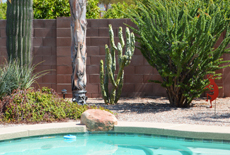
Brian and Colleen’s back yard with “totem pole” cactus – Beautiful!
Saw some interesting things- good and bad… Most homes have no lawn in the front yard, and large back yards typically have a limited amount of lawn. I think this is a good approach that saves water.
So what was used in place of lawn? It seems that at least 50% of the homes have swimming pools, and I saw some very well designed large outdoor patios and outdoor living spaces. For the landscaped areas, the ground cover of choice is small rock mulch (about 3/8″, angular rock).
Within the landscaped areas, I thought some of the plantings were a little thin. Creeping groundcovers, ornamental grasses, and massings of plants could be used more effectively to help cover the rock areas. Other features used in place of lawns were sport courts, outdoor kitchens, and shade structures.
Visiting the Desert Botanical Garden in Phoenix
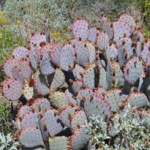
Purple Prickly Pear at the Desert Botanical Garden
This is truly an amazing garden! So many interesting cacti, agave, succulents, and native desert landscaping. They also were featuring some incredible glass sculptures by Dale Chihuly. I highly recommend visiting this garden if you are ever in the area! They have a great Facebook page as well, check it out.
Highway and Roadside Landscaping
One of the more striking features as you drive through Phoenix (and it is a very automobile dependent city) are the large swaths of roadside landscaping along the highways. Most of these areas are highly maintained slopes of rock with a few plants here and there.
My friends told me that there is a constant battle trying to eradicate the weeds from the rock- seems like a silly design solution to me. The nicer areas, in my opinion , had more plants grouped together in random, natural plantings. Other areas had formal planting in patterns and rows, or even just different color rock placed in patterns…

Aerials of Phoenix highway landscaping. Left- one of the nicer designs I saw, with random natural plantings. Right- this section had no plantings, with patterns of colored rock- not a fan of this approach.
Touring Local Nurseries
I had a chance to tour a local suburban Phoenix Nursery. I was interested to see what plants and materials were commercially available. I was happy you see that the trend of edible landscaping was equally as popular in Phoenix as it is in Denver, with a large selection of herbs, fruit trees, and other culinary delights.
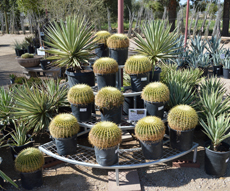
Agave, yucca, and cacti at a local suburban nursery
This nursery also had an impressive collection of sculpture and pottery- These items can add interest to a residential or commercial landscape, require little maintenance, and can serve as interesting focal points to the eye that break up large areas of rock.
One of the more interesting items for sale were packages of two Praying Mantis eggs- for natural pest control.
Hiking in the Superstition Wilderness
On my last day in the Phoenix area, my friend Brian and I went hiking in the Superstition Wilderness area. This turned out to be a very challenging hike to the top of the “flatiron” with amazing views and even more amazing native plants! I couldn’t help but think, – Why couldn’t some of those roadside highway areas be allowed to naturalize like some of this wild landscape, which received no maintenance and no irrigation?
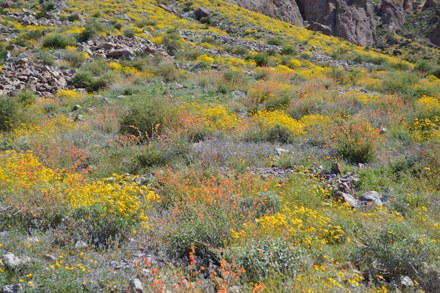
Native wildflowers- the orange flowers are Desert Mallow (Sphaeralcea ambigua), which grows great in my Denver garden!
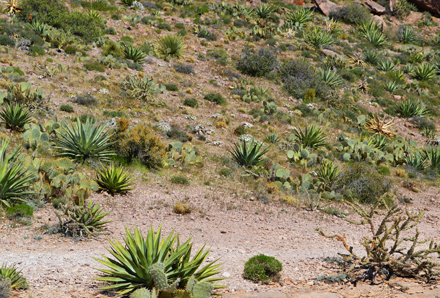
Native landscaping in the Superstition Wilderness area- Why can’t the highway roadside areas be naturalized like this?
This is the official blog of Outdoor Design Group, Colorado Landscape Architects. For more information about our business and our services, click here.
Related Posts:




